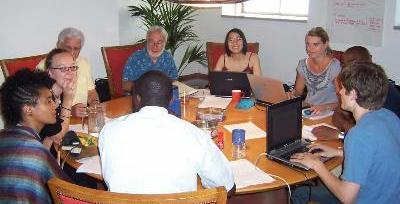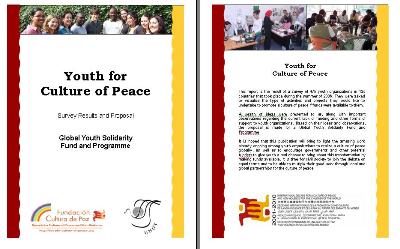Stories
Midterm Report on Culture of Peace - 2005
Youth Report on Culture of Peace - 2006
A trilogy of books for a new strategy
Final Report on Culture of Peace - 2010
Struggling with the United Nations
* * *
The Culture of Peace News Network continued
Missions for the Culture of Peace
Travels with Lindsay in the USA
Vacations with Lindsay in the Caribbean
The Youth Report of 2006 was my last very successful project with Federico Mayor and his Fundación Cultura de Paz. Mayor was nominated by Spain to head up the initial high-level group to initiate their project with Turkey for intercultural dialogue between the Islamic and Christian countries. It was called the Alliance of Civilizations.
Mayor came, along with his assistant Manuel Manonelles, to New York in June of 2006 for meetings of the Alliance at UN headquarters in New York, and I met with them at their hotel on Lexington Avenue. Mayor was disappointed by the bureaucratic nature of the Alliance initiative, and he asked me to make him a proposal for a Youth Corps modeled after the American Peace Corps under President Kennedy. I insisted instead that we should ask youth themselves what they wanted to do. "OK," he said, "give me a concrete proposal, but I must have it by September!"
Time was short. We had only two months! For a week I consulted with the youth that had worked on the 2005 Midterm Report and got their agreement to work with me on this new report with very short notice. Within one week, on July 4, I sent Mayor a formal proposal with a 32,000 euro budget, and he gave me the OK to begin.
UNOY (United Network of Young Peacebuilders), who had worked on the 2005 report, agreed to host an organizational meeting on short notice in another week at their offices in The Hague, Netherlands. It helped that their director at that time was Celina del Felice who had been a protege of Alicia Cabezudo in Argentina, and that I had a long history of collaboration with their founder Maria Kooijmans. Jo Lofgren and Gert Danielson, who had worked on the 2005 report, agreed to come and conduct a training with me and follow-up with responsibility for Europe and Latin America, respectively. UNOY agreed to be responsible for Africa.

Training for 2006 Youth Report at UNOY with team from 2005 report
Thanks to the promise of funding from Mayor, I was able to make two-month contracts with Jo, Gert and UNOY for travel, telephone expenses and full-time or half-time salaries at 2000 euros a month. I also made contracts with the Bibliotheca Alexandrina for Arab youth organizations and with Mayumi Terano for Asia. Mayumi had been an intern with me at UNESCO in Paris and was now getting a doctorate at the University of Pittsburgh.
For two months we all worked intensively. I had to supervise a few of them very closely, but Jo needed no help and she contacted an enormous number of youth organizations with their headquarters in Europe and we ended up with responses from almost 500 youth organizations. Jo and I edited the report and Jo did a beautiful job of formatting it.

Youth Report as designed by Jo Lofgren
The conclusion of the youth organizations was that the UN should set up a Global Youth Solidarity Fund that would provide grants to youth organizations to undertake projects that would promote a culture of peace and solidarity across the lines of conflict between East and West.
As we had done with the 2005 civil society report, we put together a youth advocacy teams to present the youth report to the UN ambassadors in New York. The description of this two-week intensive lobbying activity is described on our website.
By the time the report was submitted, Mayor had lost much of his influence in the Alliance and he was not able to get the report adopted and published formally by the United Nations. However, the conclusion was adopted, that there should be a Global Youth Solidarity Fund.
At my urging Jo Lofgren was hired to launch the project at UN headquarters in New York, and as long as Shamil Idriss was the interim director, she made good progress. Jo managed to get $100,000 and award it to 7 youth organizations after a global competition, aided by the mailing list of my Bulletin based on the Civil Society and Youth Reports. She also instituted one of the major recommendations of the report, which is that the Fund is administered by the youth organizations themselves to the point that the winners from one year are the judges for the competition of the following year.
With changing leadership in New York, the bureaucracy became so heavy that Jo left after a year. She was replaced by a very capable young woman, Isabelle Legaré, who managed to resist bureacratic attempts to dissolve the Fund and carry it into a second round with more funding and more projects.
 |
Stages
1986-1992
Fall of Soviet Empire
1992-1997
UNESCO Culture of Peace Programme